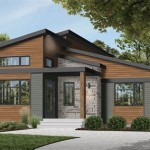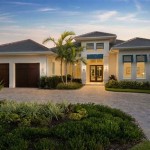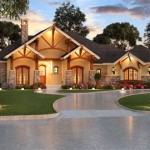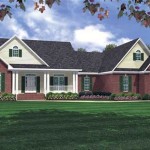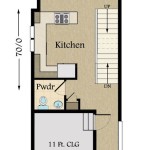Floor Plans for Single Story Homes: A Comprehensive Guide
Single-story homes, also known as ranch-style homes, remain a popular choice for a wide range of homeowners. Their accessibility, ease of maintenance, and potential for open-concept layouts contribute to their enduring appeal. Understanding the nuances of single-story floor plans is crucial for prospective buyers, builders, and remodelers alike. This article provides a comprehensive overview of the key aspects of single-story home floor plans, exploring their advantages, common layouts, design considerations, and accessibility features.
Advantages of Single-Story Living
One of the most significant benefits of a single-story home is its accessibility. Eliminating stairs makes it an ideal choice for individuals with mobility limitations, families with young children, and seniors planning to age in place. This characteristic also contributes to the home's safety, reducing the risk of falls, a major concern for elderly populations. The absence of stairs also simplifies the transportation of heavy items, furniture, and groceries throughout the home.
Beyond accessibility, single-story homes often facilitate easier maintenance. Exterior maintenance, such as window cleaning and roof repairs, becomes more manageable without the added challenge of height. Interior cleaning and upkeep are also simplified, allowing for efficient and less strenuous housework. This can translate to lower maintenance costs over the lifespan of the home.
Furthermore, single-story layouts tend to promote better energy efficiency. Heat rises, making it difficult to effectively regulate temperature distribution in multi-story homes. Single-story homes experience more consistent temperatures throughout, potentially reducing heating and cooling costs. The simplified ductwork and HVAC systems also contribute to this enhanced efficiency.
Common Single-Story Floor Plan Layouts
Several common layouts define single-story home designs, each catering to different lifestyle needs and preferences. Understanding these layouts aids in selecting the most suitable plan for a particular homeowner.
The 'linear' or 'ranch' layout is characterized by a long, rectangular design. Bedrooms are typically located at one end of the house, while living spaces are concentrated at the opposite end. This layout maximizes natural light penetration and offers a clear separation between living and sleeping areas. This design is often expanded horizontally as needed, allowing for relatively easy additions and modifications.
The 'L-shaped' layout features two wings that intersect at a right angle. This design often creates a sheltered outdoor space, such as a patio or courtyard, within the 'L.' The layout allows for a natural separation of spaces, designating one wing for bedrooms and the other for living and dining areas. This shape can be particularly effective on larger lots, providing ample space for landscaping and outdoor amenities.
The 'U-shaped' layout expands on the 'L-shaped' design, creating a more enclosed courtyard. This configuration offers increased privacy and enhanced outdoor living opportunities. The central courtyard can serve as a focal point for the home, easily accessible from multiple rooms. This design is well-suited for climates where outdoor living is a significant part of the lifestyle.
The 'open-concept' layout, increasingly popular, emphasizes seamless flow between living spaces such as the kitchen, dining area, and living room. This design fosters a sense of spaciousness and promotes social interaction. Open-concept layouts are typically found in various single-story home styles, adapting to the linear, L-shaped, or U-shaped floor plans. While creating a sense of spaciousness, careful consideration must be given to acoustic treatments to minimize noise transmission throughout the open area.
Design Considerations for Single-Story Homes
Several key design considerations are crucial when planning or modifying a single-story home. These factors impact the overall functionality, aesthetics, and value of the property.
Natural light and ventilation are particularly important in single-story homes. Since all rooms are on the ground level, careful attention must be paid to window placement and sizing to maximize natural light penetration. Skylights can also be incorporated to bring light into interior spaces. Effective ventilation strategies, such as cross-ventilation through strategically placed windows and doors, are crucial for maintaining comfortable indoor air quality.
Privacy considerations are paramount, especially in densely populated areas. Thoughtful landscaping, fencing, and window placement can help to create a sense of privacy from neighboring properties and street traffic. Orienting the home strategically on the lot to minimize exposure to busy streets or adjacent buildings is also a crucial aspect of design planning. The placement of bedrooms and bathrooms away from high-traffic areas within the house further enhances privacy for occupants.
Storage solutions are essential in single-story homes. With the absence of a basement or attic, maximizing storage space within the main living area becomes critical. Built-in cabinetry, walk-in closets, and creative storage solutions under stairs (if a split-level element is incorporated) can help to optimize available space. Utilizing vertical space with tall cabinets and shelving further expands storage capacity. External storage solutions, such as sheds or detached garages, may also be necessary to accommodate additional storage needs.
Another critical consideration is the roof design. The roof significantly impacts the overall aesthetic of a single-story home. Gable roofs, hip roofs, and flat roofs are common choices, each offering distinct stylistic and functional characteristics. The roof pitch should be considered to ensure adequate drainage and prevent water accumulation. Overhangs can provide shade and protect exterior walls from the elements, contributing to energy efficiency and reducing maintenance needs. The material chosen for the roof impacts its durability, aesthetics, and cost.
Accessibility Features and Aging in Place
Single-story homes are inherently more accessible than multi-story homes, but incorporating specific accessibility features can further enhance their suitability for individuals with mobility limitations and those planning to age in place. These features promote independence, safety, and comfort for all occupants.
Wider doorways and hallways are essential for accommodating wheelchairs and walkers. A minimum doorway width of 36 inches is generally recommended for wheelchair accessibility. Hallways should be at least 42 inches wide to allow for comfortable maneuvering. Smooth, level flooring throughout the home eliminates tripping hazards and facilitates easier mobility. Ramps or zero-step entrances provide access to the home for individuals using mobility devices. These modifications promote inclusivity and ensure that the home remains adaptable to changing needs over time.
Bathroom modifications are particularly crucial for accessibility. Walk-in showers with grab bars and adjustable showerheads enhance safety and comfort. A comfort-height toilet (17-19 inches) is easier to use than a standard-height toilet. A roll-under sink allows individuals in wheelchairs to comfortably access the sink. Reinforced walls around the toilet and shower allow for the future installation of additional grab bars if needed. These bathroom modifications promote independence and reduce the risk of falls.
Kitchen modifications can also improve accessibility. Adjustable-height countertops allow for comfortable meal preparation for individuals of varying heights or those using wheelchairs. Pull-down shelves and lazy Susans make it easier to access items in upper cabinets. Lever-style faucets are easier to operate than traditional knob faucets. A side-by-side refrigerator freezer offers easier access to both fresh and frozen foods. These kitchen modifications enhance functionality and promote independence in meal preparation.
Beyond structural modifications, incorporating smart home technology can further enhance accessibility. Voice-activated lighting and temperature controls allow individuals with limited mobility to adjust their environment without physically reaching for switches or thermostats. Remote-controlled blinds and curtains provide easy control over natural light and privacy. Smart locks allow for keyless entry, eliminating the need to fumble with keys. These technological advancements offer increased convenience, safety, and independence for all occupants.
Furthermore, the design should consider the possibility of future modifications. Ensuring that walls are load-bearing in strategic locations allows for the future installation of grab bars or other support systems without requiring extensive structural work. Providing adequate clearances around furniture and fixtures allows for easier maneuvering with mobility devices. Planning for future needs ensures that the home remains adaptable and accessible over time.
Ultimately, the appeal of single-story homes lies in their inherent accessibility, ease of maintenance, and adaptability to various lifestyles. Understanding the nuances of different floor plan layouts and incorporating thoughtful design considerations ensures that the home meets the specific needs and preferences of its occupants, providing a comfortable, safe, and functional living environment for years to come.

Must Have One Story Open Floor Plans Blog Eplans Com

Pin On Homes

Unique One Story House Plans Monster
Must Have One Story Open Floor Plans Blog Eplans Com

Elegant One Story Home 6994 4 Bedrooms And 2 Baths The House Designers Plans Floor

One Story House Plan Examples

Small One Story 2 Bedroom Retirement House Plans Houseplans Blog Com

40 X 55 2 200 Sf One Story House Plan The Escape

Stylish One Story House Plans Blog Eplans Com

Floor Plan 5 Bedrooms Single Story Five Bedroom Tudor House Plans Dream

